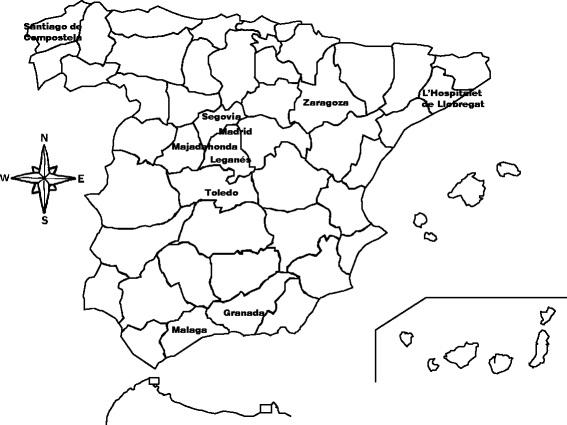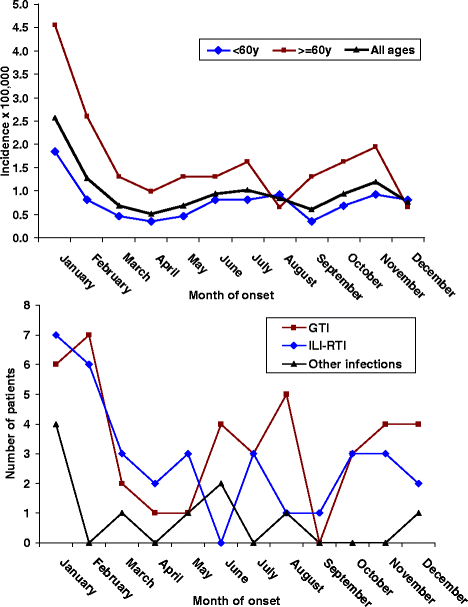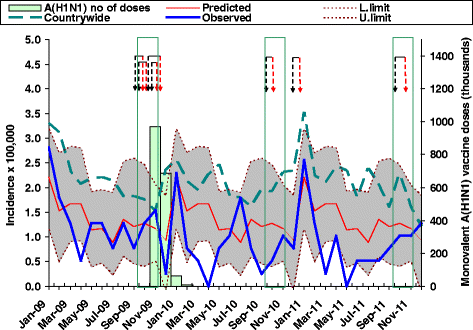Guillain-Barré syndrome following the 2009 pandemic monovalent and seasonal trivalent influenza vaccination campaigns in Spain from 2009 to 2011: outcomes from active surveillance by a neurologist network, and records from a country-wide hospital discharge database
- PMID: 27206524
- PMCID: PMC4875759
- DOI: 10.1186/s12883-016-0598-z
Guillain-Barré syndrome following the 2009 pandemic monovalent and seasonal trivalent influenza vaccination campaigns in Spain from 2009 to 2011: outcomes from active surveillance by a neurologist network, and records from a country-wide hospital discharge database
Abstract
Background: Studies have shown a slight excess risk in Guillain-Barré syndrome (GBS) incidence associated with A(H1N1)pdm09 vaccination campaign and seasonal trivalent influenza vaccine immunisations in 2009-2010. We aimed to assess the incidence of GBS as a potential adverse effect of A(H1N1)pdm09 vaccination.
Methods: A neurologist-led network, active at the neurology departments of ten general hospitals serving an adult population of 4.68 million, conducted GBS surveillance in Spain in 2009-2011. The network, established in 1996, carried out a retrospective and a prospective study to estimate monthly alarm thresholds in GBS incidence and tested them in 1998-1999 in a pilot study. Such incidence thresholds additionally to observation of GBS cases with immunisation antecedent in the 42 days prior to clinical onset were taken as alarm signals for 2009-2011, since November 2009 onwards. For purpose of surveillance, in 2009 we updated both the available centres and the populations served by the network. We also did a retrospective countrywide review of hospital-discharged patients having ICD-9-CM code 357.0 (acute infective polyneuritis) as their principal diagnosis from January 2009 to December 2011.
Results: Among 141 confirmed of 148 notified cases of GBS or Miller-Fisher syndrome, Brighton 1-2 criteria in 96 %, not a single patient was identified with clinical onset during the 42-day time interval following A(H1N1)pdm09 vaccination. In contrast, seven cases were seen during a similar period after seasonal campaigns. Monthly incidence figures did not, however, exceed the upper 95 % CI limit of expected incidence. A retrospective countrywide review of the registry of hospital-discharged patients having ICD-9-CM code 357.0 (acute infective polyneuritis) as their principal diagnosis did not suggest higher admission rates in critical months across the period December 2009-February 2010.
Conclusions: Despite limited power and underlying reporting bias in 2010-2011, an increase in GBS incidence over background GBS, associated with A(H1N1)pdm09 monovalent or trivalent influenza immunisations, appears unlikely.
Keywords: Guillain-Barré syndrome; ICD-9-CM; Influenza A virus H1N1 subtype; Influenza vaccines; Public health surveillance; Safety.
Figures



References
-
- Safranek TJ, Lawrence DN, Kurland LT, Culver DH, Wiederholt WC, Hayner NS, et al. Reassessment of the association between Guillain-Barré syndrome and receipt of swine influenza vaccine in 1976–1977: results of a two-state study. Expert Neurology Group. Am J Epidemiol. 1991;133(9):940–51. - PubMed
MeSH terms
Substances
LinkOut - more resources
Full Text Sources
Other Literature Sources
Medical

